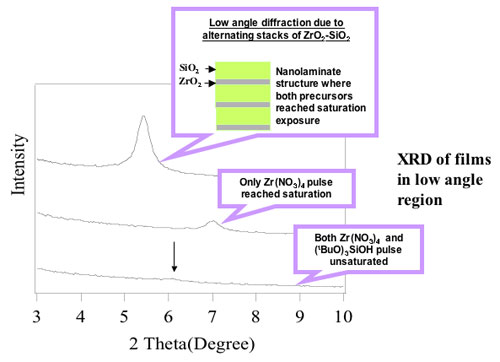
 |
|
Recent Research Developments |
|
| Index of Recent Research News |
| March 31st, 2004 |
|
|
|
In recent work of Lijuan Zhong, Fang Chen, Steve Campblell and Wayne Gladfelter, atomic layer deposition was used to deposit alternating layers of zirconia and silica. In a low-pressure chemical vapor deposition reactor, alternating exposure of silicon substrates at 162°C to anhydrous zirconium nitrate and tri(t-butoxy)silanol produced atomically smooth, amorphous films. The deposition rate, defined as the thickness (Å) per cycle, exhibited saturation behavior indicative of self-limiting growth of atomic layer deposition. However, the maximum rate of approximately 12 Å/cycle exceeded the thickness expected for a single monolayer each of ZrO2 and SiO2. Both the thickness deposited per exposure cycle and the ratio of ZrO2 to SiO2 requires a process involving multiple SiO2 units added per each ZrO2. Films deposited under conditions leading to the saturation of ZrO2 per layer displayed an ordered structure within each bilayer, which was revealed by the singular reflection in the low angle X-ray scattering pattern. Such mixture of ZrO2, a high dielectric constant oxide, with SiO2, a glass-forming oxide, is a potential replacement of SiO2 in order to conquer the direct tunneling effect associated with very thin insulator layer in field effect transistors. In this study, both the refractive indices, measured by ellipsometry, and the effective dielectric constants displayed a linear correlation to composition: a feature that may be of value in device design and construction. |

|
| * This page is updated every two weeks. Next scheduled update: Apr. 14, 2004. |
|
Copyright 2004 by the Regents of the University of Minnesota.For questions or comments, contact the Chemistry Webmaster or read the University's Online Privacy Statement. |